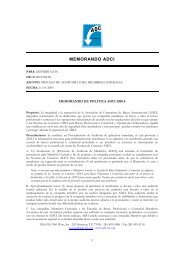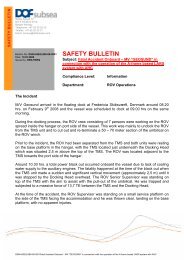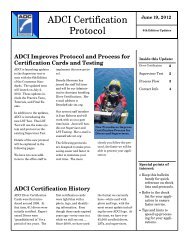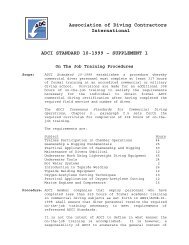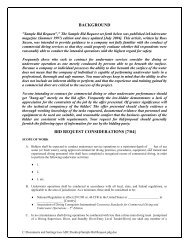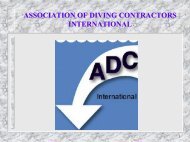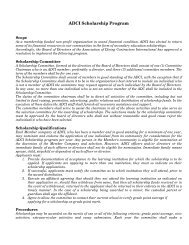DIRECTIVE NUMBER: CPL 02-00-151 EFFECTIVE DATE ... - OSHA
DIRECTIVE NUMBER: CPL 02-00-151 EFFECTIVE DATE ... - OSHA
DIRECTIVE NUMBER: CPL 02-00-151 EFFECTIVE DATE ... - OSHA
Create successful ePaper yourself
Turn your PDF publications into a flip-book with our unique Google optimized e-Paper software.
from the dive team (indicating a possible disability of the diver or an equipment<br />
failure); communications with the diver are lost and cannot quickly be<br />
reestablished (either between the diver and the dive location or diving bell, or<br />
between the diver and the designated person-in-charge and the skipper of the<br />
support vessel for liveboating operations); or the diver begins to use the reserve<br />
breathing gas. Any of these situations requires termination of the dive. The<br />
decompression interval should not be omitted after termination of the dive if<br />
doing so would add to the diver’s overall physical risk, unless the circumstances<br />
make inwater decompression impossible or present a greater physical risk to the<br />
diver.<br />
G. 29 CFR 1910.423 Post-dive procedures.<br />
1. 29 CFR 1910.423(b) Precautions. At the completion of a dive, the employer<br />
must: thoroughly check the physical condition of the diver; instruct the diver to<br />
report any physical problems or adverse physiological reactions (including<br />
decompression sickness symptoms); advise the diver of the location of the<br />
nearest decompression chamber; and alert the diver to the hazards of flying too<br />
soon after the dive. As a general rule, a diver should wait 12 hours before<br />
flying for air diving not involving decompression, and wait 24 hours for air<br />
dives involving decompression and all mixed-gas diving. For additional<br />
information, see the U.S. Navy Diving Manual or the NOAA Diving Manual.<br />
Decompression sickness effects can occur for some time after the completion of<br />
the dive, and sleep can conceal the onset of decompression sickness.<br />
Consequently, after a dive deeper than 1<strong>00</strong> fsw, a dive that requires<br />
decompression, or after any dive using a mixed-gas breathing mixture, the<br />
employer is required to instruct the diver to remain awake and in the vicinity of<br />
the decompression chamber at the dive location for at least one hour after the<br />
dive, including one hour after any decompression or diving medical treatment<br />
(such as medical treatment for decompression sickness or arterial gas<br />
embolism).<br />
2. 29 CFR 1910.423(c) Recompression capability. Decompression chambers<br />
provide the only effective therapy (i.e., recompression) for decompression<br />
sickness and arterial gas embolism. A decompression chamber also can reduce<br />
a diver’s underwater exposure since chambers may be used to decompress the<br />
diver on the surface (i.e., procedures known as “surface decompression on air”<br />
and “surface decompression on oxygen”).<br />
a. 29 CFR 1910.423(c)(1). This provision requires the use of a decompression<br />
chamber capable of recompressing the diver at the surface to a minimum of<br />
165 fsw (6 ATA) at the dive location for: SCUBA dives deeper than 1<strong>00</strong><br />
fsw; surface-supplied air dives deeper than 1<strong>00</strong> fsw but shallower than 220<br />
fsw; mixed-gas dives shallower than 3<strong>00</strong> fsw; or diving outside the nodecompression<br />
limits shallower than 3<strong>00</strong> fsw.<br />
b. 29 CFR 1910.423(c)(2). A decompression chamber capable of<br />
recompressing the diver at the surface to the maximum depth of the dive<br />
must be available at the dive location for dives deeper than 3<strong>00</strong> fsw.<br />
25


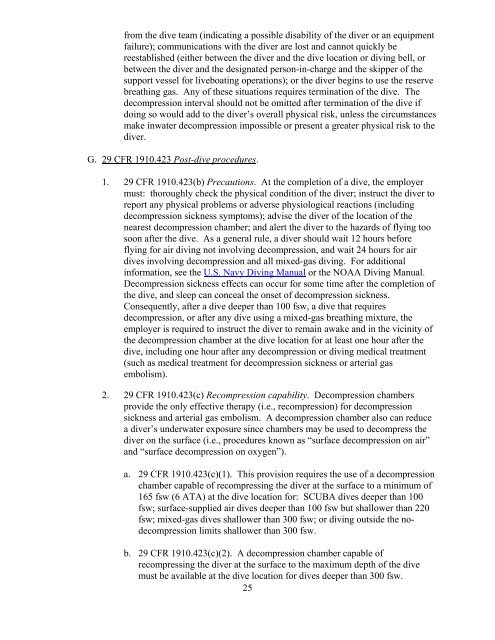
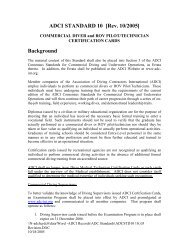
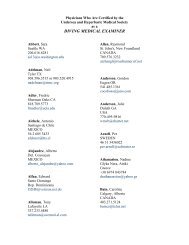
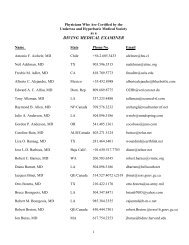
![SOLICITUD MEMBRESIA ASOCIADO [Rev 06/08] - Association of ...](https://img.yumpu.com/48291988/1/190x245/solicitud-membresia-asociado-rev-06-08-association-of-.jpg?quality=85)

